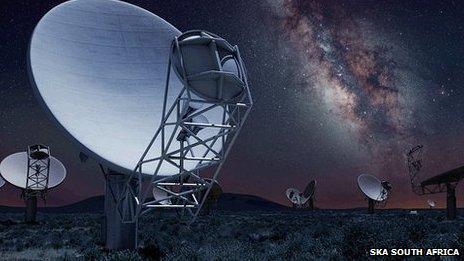Super telescope 'favours South Africa over Australia'
- Published

The Square Kilometre Array will take to the middle of the next decade to finish
Australian media are reporting that the country is running behind South Africa in the selection process for the Square Kilometre Array (SKA).
The huge £1.3bn ($2bn) radio telescope facility is being designed to answer some key questions about the Universe.
The Saturday editions of the Sydney Morning Herald and The Age, external carried a leak from a panel that has looked at the technical strengths of each bid.
But commentators said South Africa's selection was not yet a done deal.
And Dr Brian Boyle, external, the director of the joint Australia/New Zealand bid, tweeted on Saturday: "ANZ team continues to respect confidentiality of the site process. We are actively engaged in current SKA Board deliberations."
Nonetheless, the leak was enough to start a certain amount of hand wringing in Australia.
The West Australian (WA) Premier Colin Barnett told national broadcaster ABC, external that Australia could not have worked harder in its bid.
"I don't believe anything more could have been done, in terms of preparation for the Australia bid," he said.
"If we don't make it, that's a disappointment, but it's not through a lack of effort or funding by the Australian and WA governments."
Twenty nations are involved in the consortium to build the SKA. The facility will incorporate thousands of individual radio antennas over vast areas of ground, with Australia/New Zealand and southern Africa competing to be the host.
For Australia, external, the array would be centred on a site at Boolardy Station, about 500km (310 miles) north of Perth in Western Australia. For South Africa, external, the central location would be in the Karoo in the Northern Cape, about 95km from Carnarvon.
Long process
A panel of experts, known as the SKA Site Advisory Committee, delivered its assessment of the technical merits of the two sites last month.
Its report is supposed to be confidential, but given the importance and kudos attached to winning this flagship project, it was unrealistic to think the panel's deliberations would not filter out at some point.
The SKA executive board has, though, repeatedly stated in recent weeks that no final decision on the siting of the array will be announced until its members have had a chance to discuss the evaluations, and certainly not before the bid teams themselves have had the opportunity to respond to the assessments.
No formal declaration, therefore, is expected before early April, external.
Geoff Brumfiel, a science writer for Nature, posted details on the journal's breaking news blog, external of his conversation with a source familiar with the site-selection process.
Brumfiel wrote: "According to Nature's source, because the two sites are so close in merit, both are still in contention.
Bid to host Square Kilometre Array telescope
"China, Italy, the United Kingdom and the Netherlands - the SKA voting board members - could yet decide either way. It is even possible that the array could be shared between both nations, although this would probably increase the construction costs."
Like all the grand scientific projects of the 21st Century (the space station, the Iter fusion reactor, the Large Hadron Collider, for example), the immense size of the SKA means no one country can afford - or has the expertise - to carry it through alone.
The project aims to produce a radio telescope with a collecting area of one million square metres (one square km) - equivalent to about 200 football pitches.
The SKA will investigate light sources in the sky that radiate at centimetre to metre wavelengths - but it will achieve sensitivities that are far beyond the reach of current telescopes.
This should allow it to see the hydrogen in the first stars and galaxies to form after the Big Bang.
The SKA will also pinpoint precisely the positions of the nearest 100 million galaxies. Scientists hope their structure will reveal new details about "dark energy", the mysterious negative pressure that appears to be pushing the cosmos apart at an ever increasing speed.
Wherever it is built, the SKA will be an immense technical challenge.
The computing requirements alone to handle all its data will outstretch current capabilities.
The SKA's designers are hoping the continued improvements in processing power will deliver systems sufficient to the task by the time the array is fully up and running in the middle of the next decade.
Jonathan.Amos-INTERNET@bbc.co.uk and follow me on Twitter, external
- Published2 April 2011
- Published31 March 2011